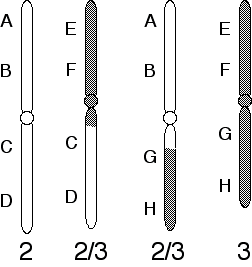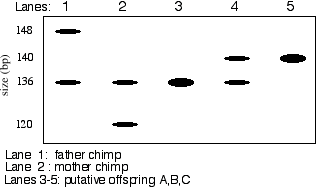 chromosomes, compared to those in a normal karyotype, are diagramed below:
chromosomes, compared to those in a normal karyotype, are diagramed below:1) 24 pts.
Short Answer section. Answer the following as briefly as possible.a) What repeating polypeptide(s) would be produced from the polynucleotide (UCAG)n in a cell free translation system?
b) A mutation that causes a-thalassemia, a human blood disorder caused by the absence or reduction of the a-subunit of hemoglobin, contains a deletion of two nucleotides just upstream of the AUG initiation codon. The normal version of the gene has the sequence CCCACCATG, whereas the mutant has the sequence CCC**ATG. (* = deleted base)
i) Does this particular deletion mutation cause a frameshift, why or why not?
ii) Why do you think this mutation causes
a-thalassemia?
c) Usually there is only a single tRNA species that carries tyrosine. What is its anticodon?
d) The restriction enzyme Eag I cuts dsDNA at 5' C'GGCCG 3' and Not I cuts at GC'GGCCGC. Would an Eag I cut fragment and a Not I cut fragment have compatible ends? If not why not? If so, could an Eag I fragment ligated to a Not I cut fragment be cut by Not I? If not why not? If so, what percentage of the time?
h) Explain the differences between a genomic and a cDNA library. Explain how you would use one or the other or both in a chromosome walk.
2) 24 pts. A woman seeking genetic counseling, was found to
be heterozygous for a chromosomal rearrangement between the second and
third chromosomes. Her  chromosomes, compared to those in a normal karyotype, are diagramed below:
chromosomes, compared to those in a normal karyotype, are diagramed below:
a) What kind of chromosomal aberration is shown here?
b) Illustrate how these chromosomes would pair during meiosis. Be sure to label the different segments of the chromosomes.
Consult the text book page 158. Note: we have a new text this year. see Chapter 17.
c) The woman is phenotypically normal. Should this surprise you? Why or why not? Under what circumstance might you expect a phenotypic effect of such a rearrangement?
d) The woman has had two miscarriages. She has come to you as her physician and genetic counselor, for advice. It's your task to provide an informed response to her concerns:
i) Is there a genetic explanation of her frequent miscarriages?
ii) Should she abandon her attempts to have a child on her own?
iii) If she continues, is she at risk of having an abnormal child?
3) 10 pts.
The following data are from 3-factor transductional crosses performed to determine the order of leucine mutations with respect to an outside linked marker arabinose. The donor in each case was ara
+ leu- while the recipient was ara- leu-. Selection was made for leu+ recombinants which were scored for incorporation of the ara+ marker. The data are presented as % leu+ ara+ relative to total leu+ recombinants.|
donor (ara +) |
Recipient (ara -) |
% ara + leu+ |
|
leu-6 |
leu-3 |
12 |
|
leu-4 |
leu-3 |
18 |
|
leu-4 |
leu-6 |
75 |
What is the order of the mutations? (Show your work for partial or full credit.)
4) 15 pts.
The first mutants defective in a DNA repair pathway were isolated by the following method: Approximately 107 heavily UV irradiated T1 phage were spread on plates. Then ~5 X 105 mutagenized bacteria were spread on each plate and incubated until colonies arose. Among these colonies were mutants that proved incapable of repairing UV induced lesions in their DNA.(a) Explain the logic of this selection scheme.
(b) Not all of the colonies that grow up are defective in DNA repair. Explain what other kinds of colonies might grow under this regimen. How would you distinguish the repair defective strains from these other bacteria?
5) 15 pts. Although the capture and trading of Great Apes is banned, it is estimated that up to 1000 Chimpanzees are illegally removed from Africa each year. Private owners often disguise this illegal trade by falsifying birth records. To combat this, new techniques are being developed to carry out genetic analysis in Apes. Recently DNA samples were extracted from chimp hair roots and used as templates in PCR reactions. The primers used flank highly polymorphic sites in human DNA resulting from variable numbers of microsatellite repeats. Several suspect chimp offspring and their reputed parents were tested to determine if the offspring were "legitimate" or were the "products of illegal trading." A sample of these data are shown.

a) Offer an explanation for the origins of the offspring in question. If there are ambiguities state them. Be sure you address whether there are enough data to draw any conclusions, and whether the use of human primers raises any difficulties for the analysis.
b) What are microsatellite repeats and why can they be highly polymorphic? How many alleles of the repeat locus are present in this group of chimpanzees?
6) 12 pts. When a clone of a transposable element is used as a probe, it is possible to clone a gene when nothing is known about the gene's sequence or amino acid product. A similar procedure may be used to clone a transposable element when nothing is known about the DNA sequence of the transposable element. Describe a protocol by which such a transposable element may be cloned.
(Note: If you can't answer this question as written, you may earn partial credit by explaining how you would carry out the experiment implicit in the first sentence.)
Extra Credit 6 pts.
About 20% of all hemophilia A cases in humans are due to an inversion with a break point in intron 22 of the F8C gene. Apparently, this particular inversion has arisen independently many times. Intron 22 is exceptionally large (32kb) and contains a complete small intron-free gene within the intron. This gene, called gene A, has several functional copies upstream from the large F8C gene. The inversion has one break point within the copy of gene A in intron 22 and the other break point is within one of the copies of gene A that lies upstream from the F8C gene. Explain and diagram how his inversion may arise, and explain why this inversion may have arisen many times independently.